- info@aromantique.co.uk
- 07419 777 451
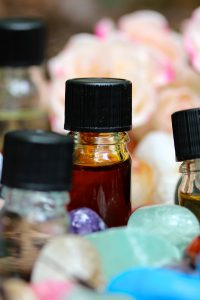 Heather Dawn Godfrey P.G.C.E., B.Sc. (Joint Hon)
Heather Dawn Godfrey P.G.C.E., B.Sc. (Joint Hon)
Gifts of nature, the healing qualities of plants range from physical to ethereal; we are inextricably connected to earths’ web of life.
….you who are born of the mountains and the forests and the sea can find their prayer in your heart. Kahlil Gibran
We share biological affinity with plants; simple examples being gaseous exchange and provision of vital nutrients that maintain and support bodily function, growth, tissue repair, energy production, and more.
In deed, healing plants and their essential oils have been used throughout history for their protective, restorative, rehabilitative, and hedonistic qualities, attributes observed and documented in ancient scriptures and medicinal texts and, more recently, affirmed in scientific journals and numerous research papers. (Godfrey 2022, 2019, 2018)
How essential oils support health and wellbeing
Perfume and incense bring joy to the heart. Proverbs 27:9
Essential oils are aromatic volatile terpene and terpenoid compounds, which are typically extracted from plants (herbs and trees, heart wood, bark, blossoms and flowers, fruits, leaves, stalks, seeds, roots, gums, and resins), mainly by steam distillation, or in the case of citrus fruits, by expression.
The process of extraction increases the concentration of essential oils, thus, their potency too; just one or two drops of essential oil is sufficient to procure significant effect. Applied as an aromatherapy treatment, their molecules are absorbed either via skin (administered in an emollient, such as vegetable oil, cream, lotion or ointment), or the respiratory system through inhalation of their vaporised droplets (applied, for example, via room diffusers, perfumes, or drops on a tissue, steam inhalation, and ‘aromasticks’); inhalation has a direct influence on the limbic (olfactory connection to the brain and neural pathways) and circulatory systems (absorption via alveoli capillaries and thence the organ systems). Certain essential oils are prescribed and administered by professional herbalists, doctors or pharmacists as medicine (contained in gel-like digestible capsules). (Godfrey 2022, 2019, 2018)
Essential oils develop within the plant during the secondary phase of metabolism (along with alkaloids, flavonoids, bitters and gums), a process instigated by photosynthesis. While not vital to the plants existence, essential oils play a significant role. For example, they stave infection, attract pollinators, repel predators, disarm invasive microbes, repair damaged tissue, and control and optimise the ambient environment (temperature and humidity) by creating a haze or mist, an auric vapour, which surrounds the plant (terpenes evaporate at high temperature, and consequently produce air flows that cool the plant and reduce transpiration). They relay messages from one part of the plant to another (thus, they are considered to be ‘hormone-like’), and to other plants in the immediate vicinity. (Godfrey 2022)
Similarly, essential oil molecules modulate various processes within the body. Their properties range across a spectrum, from immune support (anti-bacterial, anti-viral), tissue healing and regeneration, pain relieving, restorative, digestive, to psycho-somatic, revitalising, anti-anxiety, anti-depressant, uplifting, calming and grounding, and more. They are multi dynamic adaptogens (that is, they support the immune system and the body’s resilience to infection, disease and stress); they stimulate the limbic system (the emotional brain) to modulate mood and emotion, and stimulate hormone balance via the limbic systems connection to the pituitary gland. (Godfrey 2022, 2019, 2018)
Olfactory and endocannabinoid receptors
Some of these qualities are attributed, in part, to the affinity certain essential oil molecules (for example, beta-caryophyllene, a-pinene, limonene, linalool, eucalyptol and myrcene – see fig 1) share with the endocannabinoid system – hemp (from which cannabis is derived) contains cannabinoids, also volatile terpenes and phenolic compounds.
Olfactory receptors and endocannabinoid receptors are found scattered throughout the body in numerous organs and tissues (for example, the central nervous system, vascular system, lungs, gastrointestinal tract, reproductive organs, liver, spleen, brain stem, bones and skin). Endocannabinoid receptors are also found in the olfactory epithelium and the main olfactory bulb at the top of the nasal cavity, also the piriform cortex and other brain areas that process and code olfactory information.
Like the olfactory system, the endocannabinoid system plays a role in a range of functions and processes, which include sleep, mood, memory, learning, motor control, skin and nervous function, liver function, muscle formation and food intake, and interacts with the olfactory system to modulate processes such as odour sensitivity, olfactory learning and memory. However, the mechanisms by which endocannabinoid and olfactory receptors interconnect and interact are complex and still not completely realised; in deed, olfaction is an intricate process (see ‘scent detection and the olfactory system’ below).
Fig 1. Terpenes found in Hemp (Cannabis), CBD oil, and Essential Oils
beta-caryophyllene – activates CB2 (Cannabidiol) receptors which modulate immune cell function, pain relief and inflammation (also found in Black Pepper, Clove Bud, Melisa (Lemon Balm), and Ylang Ylang).
a-pinene – modulates pain relief and inflammation, promotes relaxation, aids memory and respiratory function, and supports the immune system (anti-oxidant and anti-infectious) (also found in Frankincense sacra, Cypress, Helichrysum (Immortelle), Juniper berry, Myrtle, Nutmeg, Pine, and Rosemary).
limonene – modulates the immune system, modulates inflammation, anti-tumour, eases bronchial conditions and soothes allergies (also found in Bergamot, Caraway, Grapefruit, Black Pepper, Bitter Orange, Lemon, Mandarin, and Palo Santo).
linalool – modulates pain relief and inflammation, supports the immune system (anti-infectious), protects the nervous system, eases anxiety and depression (also found in Basil linalool, Clary Sage, Coriander, Hyssop linalool, Lavender, Marjoram linalool, Neroli, Petitgrain, Thyme linalool, Ho Wood, and Ylang Ylang).
eucalyptol (1,8-cineole) – modulates inflammation and cytokine activity, supports the immune system (anti-oxidant, anti-infectious), eases chronic respiratory conditions and other chronic diseases (also found in Eucalyptus, Cajeput, Caraway, Ginger, Hyssop officinalis, Spike Lavender, Myrtle, Niaouli, Rosemary, Spanish Sage, and Tea Tree).
myrcene – supports the immune system (anti-oxidant, anti-infectious), eases neurological conditions (such as dystonia, epilepsy and Parkinson’s disease), and promotes relaxation (also found in Rosemary, Juniper Berry, Frankincense sacra, Lemongrass, and Yarrow).
(See my book Healing with Essential Oils to discover more about the chemical constituents found in essential oils.)
The olfactory system and scent detection
Be like the flower, turn your face to the sun. Kahlil Gibran
Scent molecules (terpenes and terpenoids) are detected (like a key in a lock) by olfactory receptors located at the top of each nasal cavity that, in turn, relay nerve impulses to the Limbic System located in the brain. As previously observed, odour receptors are also located in other areas of the body, such as the skin and other organs (heart, liver, lungs, kidneys and gastrointestinal tract). However, by grand design, it seems, proximity of the master olfactory portal in the roof of the nasal cavity ensures immediate awareness and instinctive reflexive responses.
The Limbic System incorporates various functional structures located in the central paleomammalian area of the brain (which include the amygdala, hippocampus and hypothalamus) that are responsible for basic physiological and emotional responses to sensory stimulation. The hypothalamus functionally connects the Limbic System to the frontal lobe (where the brain rationalises and makes sense of information and sensory input) and to the pituitary gland. The pituitary gland, also known as the master endocrine gland, initiates hormone release in response to sensory signals, activating either the sympathetic or parasympathetic nervous system, depending on the nature of the stimuli; the sympathetic nervous system prepares the body for ‘fight or flight’ (protection), and the parasympathetic nervous system maintains a state of peace and relaxation (rest and digest), and disengages the sympathetic nervous system post ‘alert’, returning the body to its optimal functional resting state.
When inhaled, some essential oil molecules will cross the blood brain barrier (especially sesquiterpenes, which are found, for example, in frankincense, carrot seed, cedarwood, German chamomile, ginger, helichrysm, myrrh, black pepper, patchouli, spikenard, and ylang ylang) where they interact with various receptor sites, such as, GABA and glutamate receptors, located in the hippocampus, thalamus, basal ganglia, hypothalamus, and brainstem (GABA is an amino acid that functions to reduce neuronal excitability by inhibiting nerve transmission).
The mechanisms by which essential molecules are absorbed and interact within the body are very complex and, although modern technology affords much insight, are still not fully realised. However, our body is clearly ‘wired’ to receive phyto-molecules; verified by the presence of numerous (olfactory and endocannabinoid) receptor sites scattered throughout the body and the multilateral physical and psychosomatic responses instigated by detection.
(Godfrey 2022, 2019, 2018)
Healing with Essential Oils
Rose (Rosa centifolia/damascena) provides a lovely example of how diverse the action of essential oils can be. The qualities of rose range from hedonistic, aphrodisiac, anti-depressant, hypnotic, and anti-convulsive, to anti-oxidant, anti-inflammatory, analgesic, antitussive (relieves coughs), antibacterial, and bronchodilatory.
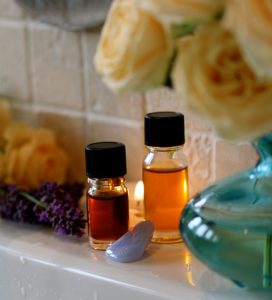 Some of the molecules found in rose oil are barely detectable yet these synergistically contribute significantly to its scent and therapeutic properties (synergy is not unique to rose oil as most essential oils demonstrate synergistic interaction between some or all of their constituents).
Some of the molecules found in rose oil are barely detectable yet these synergistically contribute significantly to its scent and therapeutic properties (synergy is not unique to rose oil as most essential oils demonstrate synergistic interaction between some or all of their constituents).
To illustrate, citronellol and geraniol, are predominant components found in rose essential oil, both of which exude floral, sweet, rose-like scents, yet the perfume of the complete essential oil is acknowledged as rich, intense, sweet, powerful beeswax-like, highly floral, rosy, with waxy, floral, spicy, green, metallic, body notes, then tenacious warm floral spicy dry out notes.
Floral, sweet, rose-like scents are also observed amongst constituent ‘notes’ in other essential oils that contain citronellol (for example geranium and citronella), and geraniol (for example, bergamot, palmarosa, thyme, and geranium). Each molecule comprising an essential oil contributes a unique ‘tone’ that combines with other molecules in various arrangements to create specific ‘tunes’ or ‘melodies’.
(Godfrey 2022)
That which we call a rose, by any other name would smell as sweet. Shakespeare, Romeo and Juliette
Lavender (Lavandula angustifolia) provides another illustration. Linalool and linalyl acetate are two predominant compounds found in this essential oil, collectively making up to 90% of lavenders chemical constituents.
The scent profile of linalool is described as citrus, floral, sweet, woody and green, and linalyl acteate, is described as sweet, green, floral and spicy, with a clean woody, terpy, citrus nuance.
Linalool is sedative, analgesic and anti-inflammatory, and also features in large quantity in other essential oils, such as, ho wood, rosewood, thyme (CT. linalool), marjoram (CT. linalool), and basil (CT. linalool).
Linalyl acetate is anti-inflammatory, sedative, relaxant and anti-hypertensive, and is present in high amount in Clary sage, petitgrain, rose, mints and bergamot FCF essential oils.
Lavender angustifolia’s overall therapeutic profile is, including those qualities mentioned above, anti-depressant, anti-microbial, antiseptic, anti-spasmodic, anti-toxic, anti-viral, bactericidal, cleansing, deodorant, hypotensive, skin healing and toning.
Spike Lavender (Lavandula latifolia), on the other hand, contains linalool and, in place of linalyl acetate, 1,8-Cineole (Eucalyptol) and a lesser amount of Camphor. 1,8-Cineole is expectorant, anti-inflammatory, antispasmodic and improves cerebral blood flow; its scent is ‘eucalyptus-like’. Camphor instigates vasodilation (dilates blood vessels and decreases blood pressure); its scent is fresh and warm. The overall scent profile of Spike Lavender thus differs from Lavender angustifolia and is accordingly described as eucalyptus, herbal, camphor, and medicinal.
These examples demonstrate how intricate and complex essential oils are. Each essential oil comprises a unique array of chemical constituents, the presence and quantity of which synergistically determine and distinguish that oils scent dynamic and therapeutic properties and qualities.
As previously established, essential oils are generally physically protective and restorative and psycho-emotionally vitalising, warming, grounding and calming. Their actions complement and gently support at one and the same time physical, mental and spiritual states.
In deed, the perception of scent instantly instigates a reflexive response within the brain that may inspire mood and emotion, compound and/or trigger memories, and conjure images – a blossoming garden in summer, woody earthy forests in spring, sweet citrus orchards in autumn, – or simply but significantly, instil feelings of peace and calm, of feeling bright and awake, and more.
The sensual experience of scent detection also draws attention to the moment, thus essential oils are wonderful companions for meditation, prayer and for moments when we simply want to centre our attention in the here and now. Thus, they are ideal companions to call upon when dealing with stress and stress related issues, including mild depression, anxiety, feelings of loss and grief, or to journey with through change and transition, or simply to compound and celebrate wellness, wellbeing, a sense of contentment, and joyful events.
The sense of smell is very personal; what one person finds pleasant another person may dislike or feel indifferent toward. Using our own nose, however, we are usually able to detect which scent is good for us at a given moment.
The essential oils listed below are among those most frequently cited as being anti-depressant and anti-anxiety, uplifting and calming. These oils may also alleviate stress related conditions, such as, insomnia, headaches, and skin disorders (eczema, psoriasis and so on), and more.
Essential oils to harmonise mood and emotion
Bergamot
Cedarwood
Chamomile Roman
Citronella
Clary sage
Corriander
Frankincense
Geranium Rose
Grapefruit
Lavender
Lemon balm (Melissa)
Lemongrass
Marjoram
Neroli
Orange
Patchouli
Peppermint
Petitgrain
Rose
Rosemary
Sandalwood
Spikenard
Vetivert
Ylang Ylang
Applying essential oils
Remember, do not apply essential oils neat to your skin, but add one or two drops to an emollient, and do not take essential oils internally unless administered, prescribed and monitored by a professional healthcare practitioner.
Vaporising a few drops of essential oils in a room diffuser, or inhaling one or two drops on a tissue or from a nasal inhaler, or applied as a personal perfume infused in vegetable oil ( applied via massage or roller bottle) or cream, are all fun, safe and very effective ways to dispense essential oils in order to experience their scents and benefit from their physical and psycho-emotional gifts.
Self-massage is also a lovely way to apply essential oils (essential oil molecules penetrate the epidermis and find their way into the circulatory system). For example, add three to six drops of essential oil to a vegetable oil or non-perfumed lotion, and then apply, using a rhythmic motion (stroking or circular movements) to face, arms, hands, legs and feet – ideally after a bath or before bed.
Go to your fields and your gardens, and you shall learn that it is the pleasure of the bee to gather honey of the flower, but it is also the pleasure of the flower to yield its honey to the bee. For to the bee a flower is a fountain of life, and to the flower a bee is a messenger of love, and to both, bee and flower, the giving and the receiving of pleasure is a need and an ecstasy. Kahlil Gribran
You will find valuable insight, practical details and reference information about the various qualities of these and numerous other essential oils in my book Healing with Essential Oils, and my other books Essential Oils for the Whole Body and Essential Oils for Mindfulness and Meditation (published by Inner Traditions, Vermont USA and available to purchase from most high street or online book suppliers).
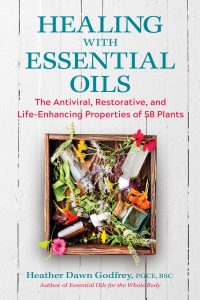
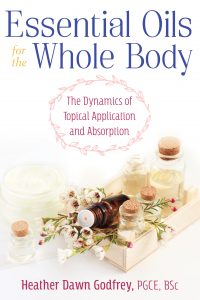
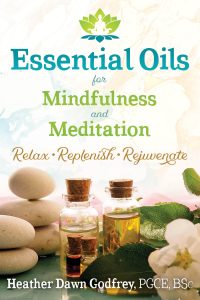
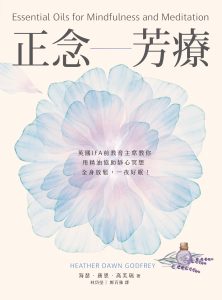
References
Agatonovic-Kustrin, S., Kustrin, E., Morton, D. W. (2019) Essential oils and functional herbs for healthy aging. National Library of Medicine. PubMed. Neural Regen Res. 14(3): 441-445. https://pubmed.ncbi.nlm.nih.gov/30539810/
Ali, B., Al-Wabel, N. A., Shams, S., Ahamad, A., Khan, A. A., Anwar, F. (2015) Essential oils used in aromatherapy: A systematic review. Asian Pacific Journal of Tropical Biomedicine, Elsevier volume 5 issue 8 p 601-616. https://cyberleninka.org/article/n/3650/viewer
Charmine, I. PhD, Oken, B. MD, PhD (2016) Aroma Effects on Physiologic and Cognitive Function Following Acute Stress: A Mechanism Investigation. Journal of Alternative and Complementary Medicine. 1; 22(9): 713-721. https://pubmed.ncbi.nlm.nih.gov/27355279/
Clarke, S. (2002) Essential Chemistry for Safe Aromatherapy. Churchill Livingstone. Harcourt Publishers, London
de Sousa, D. P. (2017) Essential Oils and Their Constituents: An Alternative Source for Novel Antidepressants. Molecules, 20(8): 1290. https://www.ncbi.nlm.nih.gov/pmc/articles/PMC6152054/
do Vale T.G., Furtado E.C., Santos Jr J. G., Viana G.S.B. (2002) Central effects of citral myrcene and limonene, constituents of essential oil chemotypes from Lippia alba (Mill.) n.e. Brown. NIH National Library of Medicine 9(8):709-14. https://pubmed.ncbi.nlm.nih.gov/12587690/
Ebrahimi, H., Mardani, M., Basirinezhed, M. H., Hamidzadeh, A. Eskandari, F. (2021) The effects of Lavender and Chamomile essential oil inhalation aromatherapy on depression, anxiety and stress in older community dwelling people: A randomized Controlled trail. Explore (NY). S1550-8307 (21)00001-X. https://pubmed.ncbi.nlm.nih.gov/33454232/
Emer, A. A., Donatello, N. N., Batisti, A. P., Belmonte, L. A. O., Santos, A. R. S., Martins, D. F. (2018) The role of the endocannabinoid system in the antihyperalgesic effect of Cedrus atlantica essential oils inhalation in a mouse model of postoperative pain. Journal of Ethnopharmacology, Elsevier, vol 210 p 477- 484 https://pubmed.ncbi.nlm.nih.gov/28917977/
Fung, T. K. H.; Lau, B. W. M.; Ngai, S. P. C.; Tsang, H. W. T. (2021) Therapeutic Effect and Mechanisms of Essential Oils in Mood Disorders: Interaction between the Nervous and Respiratory Systems. International Journal of Molecular Science 22(9): 4844
Gibran, K . (1980) The Prophet, Wlliam Heinmann, Pan Books. ISBN 0-330-26220-3
Godfrey, H. D. (2022) Healing with Essential Oils. Healing Arts Press, Rochester, Vermont USA
Godfrey, H. D. (2019) Essential Oils for the Whole Body. Healing Arts Press, Rochester, Vermont USA
Godfrey, H. D. (2018) Essential Oils for Mindfulness and Meditation. Healing Arts Press, Rochester, Vermont USA
Gupta, A., Coogler, G. (sourced June 2021) Traditional plants that engage the endocannabinoid system and their medicinal potential. Canna Foundation (Scientific studies and cannabis testing. https://www.fundacion-canna.es/en/traditional-plants-engage-endocannabinoid-system-and-their-medicinal-potential
Han, X., Gibson, J., Eggett, D. L., Parker, T. L. (2017) Bergamot (Citrus bergamia) Essential Oil Inhalation Improves Positive Feelings in the Waiting Room of a Mental Health Treatment Centre: A Pilot Study. DOI: 10.1002/ptr.5806. 31(5): 812-816. https://pubmed.ncbi.nlm.nih.gov/28337799/
Herz, R. (2016) The Role of Odour Evoked Memory in Psychological and Physiological Health. Brain Science vol 6(3). https://www.ncbi.nlm.nih.gov/pmc/articles/PMC5039451/
Hogratanaworakit, T (2009) The Relaxing effect of rose oil on humans. National Library of Medicine. PubMed. Nat Prod Commun. PMID: 19370942. 4(2):291- 6. https://pubmed.ncbi.nlm.nih.gov/19370942/
Johnson, S. A., Rodriguez, D., Allred, K. (2020) A Systematic Review of Essential Oils and the Endocannabinoid System: A Connection Worthy of Further Exploration. Hindawi Journals. Evidence-Based Complementary and Alternative Medicine.. Article ID 8035301. https://www.hindawi.com/journals/ecam/2020/8035301/
Lillehei, A. S., Halcon, L. L. (2013) A systematic review of the effect of inhaled essential oils on sleep. Journal of Alternative and Complementary Medicine. DOI: 10.1089/acm.2013.0311. 20(6): 441-51. https://pubmed.ncbi.nlm.nih.gov/24720812/
Lizarraga-Valderrama, L. (2021) Effects of essential oils on central nervous system: Focus on mental health. Phytotherapy Research. DOI: 10.1002/ptr.6854. 35(2): 657-679. https://onlinelibrary.wiley.com/doi/full/10.1002/ptr.6854
Maleki, N. A., Maleki, S. A., Bekhradi, R. (2013) Suppressive Effects of Rosa Damascena Essential Oil on Naloxone-Precipitated Morphine Withdrawal Signs in Male Mice. Iran Journal of Pharmaceutical Research. PMCID: PMC3813277. https://pubmed.ncbi.nlm.nih.gov/24250642/
Olofsson, J. K., Ekstrom, I., Lindstrom, J., Syrjanen, E., Stigsdotter-Neely, A., Nyberg, L, Jonnson, Sara, Larsson, M. (2020) Smell-Based Memory Training: Evidence of Olfactory Learning and Transfer to the Visual Domain. Chemical Senses, Oxford Academic volume 45 issue 7 p 593-600. https://academic.oup.com/chemse/article/45/7/593/5869423
Peana, A. T., D’Aquila, P. S., Panin, F., Serra, G., Pippia, P., Moretti, M. D. L. (2002) Anti-Inflammatory activity of linalool and linalyl acetate constituents of essential oils. Phytomedicine. National Library of Medicine. PubMed 9(8): 721-6. https://pubmed.ncbi.nlm.nih.gov/12587692/
Pereira I., Severino P., Santos A.C., Silva A.M., Souto E.B. (2018) Linalool bioactive properties and potential applicability in drug delivery systems. Colloids and Surfaces B Biointerfaces 171:566-578. NIH National Library of Medicine https://pubmed.ncbi.nlm.nih.gov/30098535/
Salehi B., Upadhyay S., Orhan I.E. Jugran A.K., Jayaweera S.L.D., Dias D.A., Sharopov F., Taheri Y., Martins N., Baghalpour N., Cho W.C. Sharifi-Rad J. (2019) Therapeutic Potential of a- and B-Pinene: A Miracle Gift of Nature. Biomolecules NIH National Library of Medicine 9(11): 738 https://www.ncbi.nlm.nih.gov/pmc/articles/PMC6920849/
Sanchez-Vidana, D. I., Ngai, S., P-C, Chow, J. K-W Chow, Lau, B. W-M, Tsoan, H. W-H (2017) The Effectivess of Aromatherapy for Depressive Symptoms: A Systematic Review. Evidence Based Complementary and Alternative Medicine. 5869315. https://www.hindawi.com/journals/ecam/2017/5869315/
Soel G.H., Kim K.Y. (2016) Eucalyptol and its role in chronic diseases. Advances in Experimental Medicine and Biology. NIH National Library of Medicine 929:389-398 https://pubmed.ncbi.nlm.nih.gov/27771935/
Setzer, W. N. (2009) Essential Oils and anxiolytic aromatherapy. Sage Publications, Journal of Natural Product Communications vol 4 no 9 p 1305- 1316.
Terral, G., Marsicano, G., Grandes, P., Soria-Gomez, E. (2020) Cannabinoid Control of Olfactory Processes: The where it matters. PMC7230191. Genes (Basal) 11(4): 431. https://www.ncbi.nlm.nih.gov/pmc/articles/PMC7230191/
The Good Scents Company (accessed July 2021) http://www.thegoodscentscompany.com/data/rw1007872.html
Tisserand, R., Young, R. (2014) Essential Oil Safety 2nd ed. Churchill Livingstone, Elsevier, London
Turcotte C., Blanchet M-R, Laviolette M., Flamand N. (2016) The CB2 receptor and its role as a regulator of inflammation. Springer Cellular and Molecular Life Sciences 73(23): 4449-4470 https://www.ncbi.nlm.nih.gov/pmc/articles/PMC5075023/
Yu L., Yan J., Sun Z. (2017) D-limonene exhibits anti-inflammatory and antioxidant properties in an ulcerative colitis rat model via regulation of iNOS, COX-2, PGE2 and ERK signalling pathways. Molecular Medicine Reports. Spandidos Publications 6241 p 2339-2346 https://www.spandidos-publications.com/mmr/15/4/2339
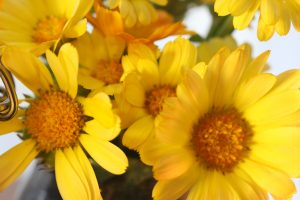
Heather Dawn: Godfrey. P.G.C.E., B.Sc. (Joint Hon)
This article explores ways in which to support your immune system, and describes how essential oils can play a significant role.
For in-depth detail about the properties and qualities of essential oils and how to apply them safely and effectively, please refer to my books, Healing with Essential Oils, Essential Oils for the Whole Body and Essential Oils for Mindfulness and Meditation.
The article below includes excerpts from my new book, Healing with Essential Oils (working title), which is due to be published by Healing Arts Press, Inner Traditions, winter/spring 2022.
We have an intrinsic symbiotic and mutualistic relationship with plants. At the very least we depend on them to maintain the correct atmospheric gaseous balance between oxygen and carbon dioxide. They provide vital nutrients, including minerals, medicines, and energy from the biosynthesis of carbohydrates; they nourish, heal and vitalise. Fibrous plants provide materials for crafting clothes, tools and implements. And so on.
Not all plants contain essential oils, and not all essential oil containing plants are safe to consume.
Essential oils occur in plants as secondary metabolites. They are not vital to the plants existence, yet they play a significant supporting role. For example, essential oils exude volatile chemicals as a vaporous haze around the plant to ward off and protect the plant from predators and harmful microbes, and attract pollinators such as bees, butterflies, birds, and animals. This haze also reduces water loss, and relays signals to other similar plants. Within the plant essential oils behave like hormones, relaying messages in response to changes in atmospheric conditions, tissue injury, damage or disease, and invasive microbes, among other things. Essential also possess anti-microbial properties that help stave off infection and disease, and also have tissue-regenerating properties.
Just as within the plant, essential oils are not vital to our existence, yet gift us similar protective, restorative and regenerative properties.
Like a lock for a key, olfactory receptors detect volatile scent molecules and relay neural signals to the brain. Receptors are found not only in the nasal cavities, but also in other tissues and organs throughout the body, including the skin. Neural signals reach the Limbic System (the instinctive and emotional centre of the brain), which is connected, via the hypothalamus, to the pituitary gland (the master endocrine gland) and the frontal lobe of the brain (where we rationalise and make sense of information). Essential oils, thus, influence mood and emotion, aid memory, concentration, invoke mental alertness, stimulate hormone release, and more. Their molecules also rejuvenate and heal soft tissue. They aid metabolic function. They are adaptogenic (that is, they tend to target their actions according to need). They are restorative and protective. They support the immune system.
The human microbiome, just like a plants microbiome, consists of trillions of microbes, including viruses, bacteria and fungi, which symbiotically live in and on the body – on the skin, in the gut, and in cavities such as the mouth, ears and vagina – and within an auric-like cloud surrounding the body. The micro biome plays a significant role in protecting and maintaining immunity, and aids a number of vital bodily functions: for example, assisting the breakdown and synthesis of nutrients in the gut and aiding their appropriate absorption, and providing a protective barrier against invasion or proliferation of harmful microbes and pathogens, and more. We coexist with microorganisms; our body houses, feeds, and depends on their presence to maintain functional equilibrium. Poor diet, sugary refined foods, overuse of antibiotics and pharmaceutical drugs, stress and illness, among other factors, can disrupt the harmonious balance of the micro biome, and thus, increase our susceptibility to pathogenic invasion, disease and dysfunction.
Our first line of defence, when considering immunity, is to support our micro biome’s equilibrium (and thus also our health and vitality through optimum absorption, nourishment and resistance): for example, eating nutritionally rich, fresh, seasonal, unrefined, organic whole foods, especially green vegetables, fruits, nuts, beans and other legumes, fermented foods, and so on; drinking plenty of water to hydrate and oxygenate our cells, and flush out waste material from our system; also, fresh air, sunlight (photochemical formation of vitamin D), walking (movement and motion) and gentle exercise (to stimulate peristalsis in the gut, and stimulate the lymphatic system, to remove waste products efficiently from our body). A plants micro biome can also feed ours, hence the advisability of leaving the skin on organic vegetables and fruits, and eating these raw or just lightly cooked.
Our body, according to Tisserand (2020), is biologically programmed to react to essential oil constituents. Essential oil molecules interact with a variety of receptor sites, neurochemicals and enzymes, thus affording potential for therapeutic activity. In deed, the therapeutic action of essential oils is well evidenced, particularly in relation to pain management, wound healing, microbial staving, also anxiety, depression, agitation, insomnia, alertness and cognitive function.
The boundaries between physical, psychological and emotional (body, mind, and spirit) often overlap, as essential oils are shown to influence these both independently and together. Indeed, feeling happy, relaxed and calm, positive and optimistic demonstrably influences physical function; heart rate, blood pressure, cortisol levels, endorphin release, digestion, and so on. Therefore, our second line of defence, in terms of immunological support and healthy function, is our state of ‘being’ – ‘being in stress’ or ‘being in equanimity’, ‘being in fear’ or ‘being in peace’. Indeed, we are often reminded that unconditional ‘love’ is an optimum state of ‘being’. Our state of ‘being’ influences our state of ‘body’.
Hygiene, of course, is another line of defence. That is cleanliness, soap and water, rather than obsessive sterilisation. Observation of our microbiome, as already established, demonstrates that microbial co-existence is the background reality; far from being harmful, we actually thrive in their presence (as explained above) – our microbiome plays a significant role in fighting invading pathogens. There are times, though, when our natural defence mechanisms are compromised, perhaps through illness, stress, shock, anxiety, poor diet, lack of sufficient sleep, among other reasons, and this is when essential oils may ‘come into their own’ as supporting agents.
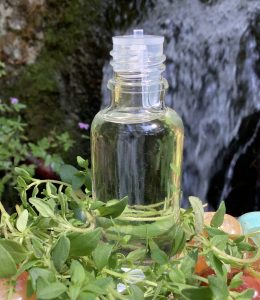 What are essential oils?
What are essential oils?
Essential oils comprise of a concentrated mixture of up to two-hundred-and-fifty or so organic terpene (hydrocarbon) and terpinoid compounds (terpinoids are oxygenated hydrocarbons). Oxygenated compounds are grouped with other similar compounds according to their chemical structures and oxidising behaviours and classified collectively as a functional group: for example, alcohols, phenols, aldehydes, ketones, oxides, esters and ethers. Taken as a whole, though, all compounds in an essential oil contribute to its synergistic quality and therapeutic value. Knowing which functional group(s) predominates, however, provides a useful initial guide when determining potential therapeutic actions, scent profiles, hazards and contra-indications.
For example, lemongrass essential oil comprises of a large proportion of aldehydes (71%) – geranial (41%) and neral (30%) – and a small amount of limonene (0.28%), a monoterpene, among other compounds. Aldehydes are anti-infectious, anti-inflammatory, anti-fungal, and calming to the nervous system. Yet they are very reactive and readily oxidise to form organic acids: rendering them skin irritants and sensitisers, especially if they are not stored appropriately. In terms of scent profile, geranial has a light sharp, fresh odour, characteristic of lemon. Neral has a light, sharp odour, somewhat less fresh than geranial. Limonene has a lemony sometimes turpentine-like odour. As a whole, including the remaining smaller compounds not identified previously, the odour of lemongrass is described as being fresh, citrus, slightly oily; with strong, lemony, herbal, green, tea-like body notes; and herbaceous somewhat oily dry-out notes (Williams 2006).
The Antimicrobial Qualities of Essential Oils
Essential oils are (with varying degrees of strength depending on the presence and combination of chemicals in their mix) generally anti-viral, anti-bacterial, anti-fungal, anti-inflammatory, and mucolyptic. They can be applied to prevent and stave the spread of infection, and ease symptoms, such as pain, digestive upset and headaches, cold and ‘flu-like’ symptoms, and to treat skin conditions. Even when applied in very small amounts, essential oils may ease psycho-emotional conditions (low mood, anxiety, brain fog, etc.), minor infections (coughs, colds, insect bites) and skin conditions (cuts, grazes, eczema, dry skin, etc.). It is advisable to seek medical advice before self-treating acute, potentially infectious conditions, such as influenza, or other viral conditions, or conditions of which you are unsure of.
A large quantity of essential oil is required to fumigate an environment (at least 30 drops depending on the size of the space); this is best done when no one is in the room to avoid irritation (eyes, nose, throat and lungs). To fumigate safely and efficiently, close all doors and windows to contain the essential oil infused vapours, and diffuse for 30 minutes. Leave the room during fumigation. Once fumigation is complete, open windows and doors to allow an inflow of fresh air to clear residual vapours.
Dried herbs, such as sage, rosemary, and juniper can be used instead of essential oils – these are usually ‘smoked or smudged’, that is, smouldered, to cleanse the atmosphere of pathogens.
Essential Oils that are strongly anti-microbial
Please note that some of the essential oils listed below are strong irritants and sensitisers Always check the qualities and contra indications of an essential oil before applying it, and do not diffuse essential oils near the head-space of infants (who are more easily prone to respiratory irritation).
Apply 2-3 drops on a tissue and inhaled, 2-4 drops in steam inhalation, 2-4 drops in 10ml of carrier medium (vegetable oil, non-perfumed, lotion, cream, or aqueous gel) for skin application – do not use these oils or blends of these oils neat on skin or in the bath.
Cinnamon bark
Clove bud/leaf
Eucalyptus blue gum / radiate / globulus
Tea tree
Thyme red
Geranium bourbon/rose
Lavender
Lemon
Scotch Pine
These are but a few popular examples. For more essential oils and further information about the antimicrobial properties of essential oils, please refer to my book, Healing with Essential Oils (Inner Traditions, Bear and Co.)
Guidelines for safe use
If essential oils are used frequently, for whatever reason (in beauty products, as perfumes, for minor conditions, for relaxation, and so on), then regularly change the oil or blend of essential oils you use (there are numerous essential oils with similar qualities, so alternatives are available) and have a break from use every so often. This will reduce the risk of sensitisation.
Add up to 15 to 20 drops of essential oil to a hand sanitizer (non-perfumed liquid soap dispenser). Do not add essential oils to an antibacterial sanitizer or pre-scented sanitizer (it is not necessary, and avoids risk of irritation). Soap, itself, is antibacterial – soap and water (careful hand washing and drying) are usually sufficiently effective.
Do not diffuse irritating essential oils in public spaces or too close to other people. Always dilute essential oils in an emollient (for example, vegetable oil, cream or lotion) when applying them to skin.
Regularly change the essential oil, or the combination of essential oils, applied in a blend, to avoid sensitisation (as previously mentioned). Do not take these or any essential oils internally (unless under specific professional medical or healthcare supervision). Babies, children, people who are asthmatic or have other pre-existing respiratory conditions, or very elderly or frail, are especially vulnerable in terms of sensitisation and potential irritancy of their airways when exposed to essential oil vapours.
Essential oils and sustainability
Purchase essential oils from suppliers who obtain their oils from sustainable sources.
Due to increased popularity, the market potential of essential oils has increased exponentially in recent years. This increases propensity for product abuse. A pure essential oil is the unadulterated product of extraction, nothing more, nothing less. A good supplier will provide certified evidence of an essential oils origin and chemical composition, and will verify that their oils are derived from a sustainable source.
Summary
Applied appropriately, essential oils are ‘scentually’ very pleasant, safe and incredibly versatile with regard to their therapeutic actions (for example, anti-microbial, skin care and tissue regeneration, psycho-emotional, and more). They are valued for their preventative and supportive properties (for example, anti-inflammatory and tissue regeneration), and may be useful during the early stages of an infection. However, although some essential oils posses a broad spectrum of anti-microbial and antibiotic-like qualities and actions, others are more specific and/or have weaker strength and potency. A clear understanding of an essential oils individual anti-microbial components and the nature of pathogens and how these infiltrate the body, is required to target essential oils effectively and safely. If symptoms are persistent, unexplained, or you feel generally unwell, you are advised to seek medical advice from a certified healthcare professional.
References
Author bio
Heather was introduced to essential oils, alongside other integrated therapy principles and practices, in the early 70’s. She later studied at the University of Salford, gaining a BSc (Joint Hon) Degree in Counselling and Complementary Medicine, and post-graduate Masters Certificates in Integrated Mindfulness, and Supervision of Counsellors, and a Post Graduate Teaching Certificate (PGCE) (Bolton Institute).
Heather taught for several years at the University of Salford in the School of Health Sciences and Social Care.
Relocating from Lancashire to Dorset a few years ago, Heather continues to run a private aromatherapy clinic, and teaches essential oil related courses and workshops.
Healing with Essential Oils (published by Healing Arts Press, Inner Traditions Bear & Com, Vermont USA)

Essential Oils for Mindfulness and Meditation (published by Healing Arts Press, Inner Traditions, Bear & Co., Vermont USA)

Essential Oils for the Whole Body (published by Healing Arts Press, Inner Traditions, Bear & Co., Vermont USA)

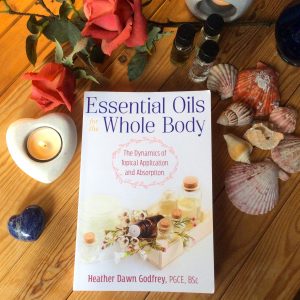 Essential Oils for the Whole Body
Essential Oils for the Whole Body
Did you know that energy in human beings resonates with colored light?
Light allows us to actually see colors. Because light itself is effusive, we can’t catch and hold it. But there’s also a denser, physical kind of colored light. Colored pigments are understood as things. They’re part of objects that we can grasp and use.
Recognizable objects such as gemstones are colored by pigment. Colored pigments are also visible to a lesser extent in essences. An essence such as the product of plant distillation is known as an essential oil.
Do essential oils have energy?
If so, what’s the value of adding color energy to already energetic essential oils? Well, it turns out that color actually impacts the properties of an oil, increasing or decreasing energy where healing is needed.
So says Heather Dawn Godfrey in her new book, Essential Oils for the Whole Body, published by Healing Arts Press in November, 2019.
Godfrey, an aromatherapist, selected 15 essential oils to address psychological imbalance and common physical diseases. As a group they are called the Serenity Oils. She describes how Serenity aromas and their connections to colors can regulate the distribution of energy in the body.
While the book appears to be a self-help guide on the safe use of essential oils, there are many points of interest for a practicing aromatherapist. I was attracted to the ideas of using light, energy centers, and subtle connections that Godfrey incorporates throughout her discussion of using essential oils for wellbeing.
Graphical charts are seen throughout Essential Oils for the Whole Body. Some charts offer basic information on essential oils, while others associate Serenity oils with gemstones, plus other subtle energies such as Yin and Yang for example.
One chart shows a selection of oils for 24 different emotional conditions.
I noticed that 10 essential oils can relieve anxiety, depression, insomnia, and nervous tension. As well, I see there’s a really broad spectrum of healing oils for emotional conditions. The possibility of transforming imbalance, then, looks like it’s within reach.
Godfrey explains that the pairing of essential oils and gemstones is a method of healing. With this technique, subtle energies combine with essential oils to relieve an imbalance in energy. Then essential oils with their corresponding gemstones and colors can address discomfort and pain.
From an aromatherapist’s point of view, knowledge of human anatomy is vital to any practice. The endocrine, respiratory, and integumentary systems in particular, serve to inform the use essential oils for healing. Properties of the oils are found throughout Essential Oils for the Whole Body and in Profiles, a section which portrays the characteristics of each Serenity Oil.
A state of balance can be achieved by potent aromatic and medicinal oils. Because gemstones reinforce aromas and properties, they can assist inbalancing energy, according to Godfrey. In the end, a smaller amount of essential oil is necessary to achieve expected results.
Features of each energy node are compiled in the chart, “The Chakras: Connections and Associations”.
In a review of chakras, or energy nodes, Godfrey describes these points of energy as a part of the body and organs involved, but also the emotional aspect, which that body part expresses.
Godfrey’s “connections and associations” chart for the chakras has assigned the following features for the heart chakra:
compassion, emotion, patience, self-determination, self-love, tolerance and acceptance… etc.
The combined energy of a chakra with the person’s emotional response makes that chakra either strong or weak. When all chakras are balanced, a state of wellbeing is achieved. Thus, when a particular body part is in pain, the energy imbalance in the energy center might uncover the reason for distress.
What fascinates me is that you need two colors, rather than one, in order to balance an energy. How this works, says Godfrey, is that the two colors must be complementary, meaning opposite colors. Yellow is opposite of violet. As a pair, they create a kind of friction or movement. Then the combined energy of the two colors can “resonate with” a chakra.
Color energy from two gemstones can affect healing. Godfrey’s specific data helps to choose the appropriate color energy or gemstone to go with a Serenity oil or blend.
To alleviate sleep issues, you could choose from one of Godfrey’s essential oils.Geranium (Pelargonium graveolens) essential oil helps balance your emotions. It also regulates the activities of your solar plexus, a very important chakra or energy center, just below your sternum and rib cage.
If you decide on Geranium to support the solar plexus, you’ll also note that Geranium is symbolized by the color yellow. And consequently, the yellow-golden gemstones such as Citrine or Amber or Tiger’s Eye are associated with Geranium essential oil.
Associated with gold-hued colors and gemstones, Geranium positively affects mood, nervous tension, and mood swings (and a number of other conditions, p. 209) because it stabilizes your solar plexus. It sorts through all your influencers and stressors in a physical way.
So, knowing that the chakra or bodily energy node called solar plexus corresponds to golden-colored gemstones, we also find information on opposing energies. The opposite of yellow is violet, hence the gemstone to balance citrine, etc. is amethyst, a violet colored gem.
Three elements of application are key to effective essential oil use. They are absorption, blending, and safety issues.
Absorption is possible through breathing, skin contact, and ingestion. To wit, I think the title phrase, “The Dynamics of Topical Application and Absorption” speaks to the very question of how oils can increase wellness. You might say that absorption is at the heart of the matter.
But although absorption is critical, combining oils is the 2nd element to consider. Blending creates different effects, aesthetic and/or therapeutic. Godfrey’s method of blending combines the art of selection and perfumer’s sense of odor characteristics.
The third element of application is safety. For issues of safety, I don’t think her point of view is unique, as most aromatherapists are attuned to safe delivery of the oils, no matter the pathway. However, her indications for safety include data on essential oil contraindication in pregnancy and use with children. Specific oils are mentioned in charts, which is very helpful for quick reference. Godfrey also advises that for most applications to the skin, you should dilute essential oils to between 1% and 5% concentration in a carrier medium.
Two more topics in Essential Oils for the Whole Body provide practical advice. Each of the 15 essential oils is described from native plant environment to oil in the bottle. Godfrey then gives instructions on how to create products for topical application.
Profiles is a mini reference manual on each of the 15 Serenity Oils. This section is typical of materia medica, but in Essential Oils for the Whole Body there are also colors, gemstones, chakras, energies, and elements relevant to each oil. As well, and given in even more detail, are odor descriptions, safety data, and chemical constituents. These expose a vaster playing field than I might have guessed.
Provided in Applications are Godfrey’s recipes for 15 different types of application — ointments, lotions, creams, face masks, compresses, resin burners, diffusors — ways to use the potential of essential oils to affect healing and grace. One shown at top has Rosehip Seed Oil, Sunflower Oil, Beeswax, and a blend of essential oils for relief of painful skin splits around nails.
At first, I thought that the many details of human anatomy, which can be found elsewhere, takes away from the impact of Godfrey’s message on the essential oils themselves.
But not quite. After considering her description of subtle connections, I had an ah-ha moment. It seemed to me that if essential oils combine with subtle energies in a healing technique, a bridge would be provided in the text between the Eastern and Western ideas.
And so a bridge, or crosswalk does exist with essential oils. For example, I’ve selected an essential oil to help with personal power, self-confidence and self-expression. And because the bodily function of digestion is also related to these emotions, then the digestion of experiences will also be positively affected. Taken together, the significance of two systems seems obvious, yet Godfrey’s manner of expressing these details offers the reader several options.
Indeed, Godfrey describes Western and Eastern concepts with equal sensitivity. She’s chosen to highlight non-Western perspectives. Portraying energy as a collaboration between the mind and the body, Godfrey discusses the 7 Chakras and the Chinese way of Yin and Yang.
Godfrey’s considerable knowledge combined with her ability as teacher is also mindful of connections and correspondences. This passion for the energy of light and color with essential oils brings forth the possibility that transformation is at hand!
Read more about Heather Dawn Godfrey at Inner Traditions website here.
Read my review of her first book, Essential Oils for Mindfulness and Meditation, here.